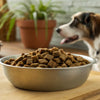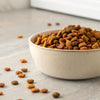Elevate Your Dog's Dining Experience: What Can I Mix in My Dog's Dry Food?
- Houndsy
Table of Contents
- Introduction
- Understanding Your Dog's Nutritional Needs
- Why Mix in Fresh Ingredients?
- 25 Ingredients to Mix with Your Dog’s Dry Food
- How to Safely Introduce Mix-Ins
- The Houndsy Kibble Dispenser: Elevating Mealtime
- Conclusion
Introduction
Did you know that nearly 60% of dog owners report their pets being picky eaters at some point? As dog lovers ourselves, we understand the frustration of watching our furry friends turn their noses up at their kibble. It's not just about the food; it's about making mealtime enjoyable and nourishing for our beloved companions. That's why we're excited to dive into the topic of enhancing dry dog food with a variety of mix-ins that not only boost flavor but also improve nutritional value.
In this blog post, we will explore the best ingredients to mix into your dog's dry food, the benefits of each, and how to ensure that the additions are safe and healthy. We'll also share how these practices align with our mission at Houndsy to elevate the dog-feeding experience, making it more convenient and visually appealing. By the end of this article, you'll have a wealth of knowledge on what can be mixed in your dog's dry food to create a delightful dining experience for your pooch.
So, grab a seat and let’s explore how we can transform our dogs' meals together!
Understanding Your Dog's Nutritional Needs
Before we dive into the mix-ins, it's essential to understand the fundamental nutritional requirements of dogs. A balanced diet for dogs typically includes proteins, carbohydrates, fats, vitamins, and minerals. While high-quality dry dog food can meet these needs, adding fresh ingredients can provide variety and excitement to their meals.
- Proteins: Essential for muscle development and repair.
- Carbohydrates: Provide energy and help with digestion.
- Fats: Important for skin and coat health.
- Vitamins and Minerals: Support overall health and immune function.
When considering what to mix with your dog's dry food, it's crucial to ensure that these additions complement their existing diet without exceeding their caloric needs or upsetting the balance of nutrients.
Why Mix in Fresh Ingredients?
Adding fresh ingredients to your dog's dry food can serve various purposes:
- Enhances Flavor: Picky eaters will be more inclined to consume their meals.
- Boosts Nutrition: Fresh ingredients often contain essential nutrients that can enhance your dog's health.
- Variety: Just like us, dogs enjoy variety in their diet, which can prevent boredom and encourage a healthy appetite.
Now, let’s take a look at some of the best options for mixing into your dog’s dry food.
25 Ingredients to Mix with Your Dog’s Dry Food
1. Cooked Chicken
Chicken is a lean protein source that can be shredded and mixed with dry food. It's not only tasty but also provides essential amino acids that support your dog's muscles and overall health.
2. Canned Pumpkin
Pumpkin is rich in fiber which aids digestion. A small spoonful of plain canned pumpkin (not the sugary pie mix) can add moisture and a hint of sweetness to your dog's meal.
3. Peanut Butter
Most dogs adore peanut butter! It’s a great protein source and can make their kibble more palatable. Just ensure it’s xylitol-free, as this sweetener is toxic to dogs.
4. Eggs
Eggs are packed with protein and essential fatty acids. You can serve them scrambled or hard-boiled. They’re also an excellent source of biotin, which is good for the skin and coat.
5. Greek Yogurt
Plain, unsweetened Greek yogurt can be a tasty and healthy addition. It’s rich in probiotics which can aid digestion and support gut health.
6. Canned Fish
Fish like tuna or salmon is high in omega-3 fatty acids, which are great for skin and coat health. Ensure it’s packed in water without added salt.
7. Sweet Potatoes
Cooked or mashed sweet potatoes are nutrient-dense and provide fiber. They can be a fantastic carbohydrate source, adding natural sweetness to your dog's food.
8. Green Beans
Low in calories and high in fiber, green beans can be served cooked or raw. They are a great crunchy addition that many dogs enjoy.
9. Carrots
Carrots are another crunchy, low-calorie treat. You can give them raw or cooked, and they provide vitamins and minerals beneficial for health.
10. Apples
Chopped apples (without seeds) can be a sweet treat packed with vitamins A and C. Just be mindful of the sugar content and offer in moderation.
11. Oatmeal
Cooked oatmeal is a good source of fiber and can help soothe a dog's digestive system. It’s particularly beneficial for dogs with sensitive stomachs.
12. Broth
Adding low-sodium chicken or beef broth can enhance the flavor of dry food and make it more appealing. Just ensure it's free from onion and garlic, which are harmful to dogs.
13. Cheese
In moderation, cheese can be a tasty mix-in. Opt for low-fat varieties and ensure your dog is not lactose intolerant.
14. Cottage Cheese
Cottage cheese is another dairy option that's high in protein and calcium. It can add creaminess to your dog's meal.
15. Cooked Beef
Lean, cooked ground beef can provide high-quality protein. Just be sure to drain any excess fat before mixing.
16. Liver
Cooked liver is nutrient-dense and can be a powerful addition to your dog’s diet. Just a small amount goes a long way in providing vitamins and minerals.
17. Flaxseed Oil
Adding a few drops of flaxseed oil provides healthy fats that are excellent for skin and coat health.
18. Coconut Oil
Coconut oil can be beneficial for digestion and skin health. It adds a pleasant flavor but should be used sparingly due to its high-fat content.
19. Quinoa
This grain is a complete protein source, making it an excellent addition for a balanced diet. Just be sure to cook it before serving.
20. Frozen Fruits
Frozen blueberries or strawberries can be a refreshing treat. They’re full of antioxidants and can be a fun addition to your dog’s bowl.
21. Cooked Lamb
Similar to beef and chicken, cooked lamb provides good protein. Ensure that it’s lean and cooked without any seasonings.
22. Zucchini
This low-calorie vegetable can be sliced or pureed and mixed in for a refreshing addition to your dog’s meal.
23. Broccoli
Rich in fiber, broccoli can be served steamed or raw. Like other vegetables, it should be given in moderation due to potential gas-producing properties.
24. Rice
Cooked white or brown rice can be a digestible carbohydrate source, especially for dogs with sensitive stomachs.
25. Bone Broth
Homemade bone broth (without onions or garlic) can add flavor and hydration to dry food, making it an excellent mixer.
How to Safely Introduce Mix-Ins
When adding new ingredients to your dog's diet, here are some key points to keep in mind:
- Start Slow: Introduce one new ingredient at a time and observe your dog's reaction. This helps you identify any potential allergies or intolerances.
- Monitor Portions: Ensure that the mix-ins do not exceed 10% of your dog's daily caloric intake to maintain balanced nutrition.
- Consult Your Vet: If your dog has specific health conditions or dietary restrictions, it's always wise to consult with your veterinarian before making significant changes to their diet.
The Houndsy Kibble Dispenser: Elevating Mealtime
As we explore the world of dog food mix-ins, we believe that the way we serve our dogs matters just as much as what we serve. At Houndsy, our flagship product, the Houndsy Kibble Dispenser, is designed to make the feeding experience both convenient and aesthetically pleasing.
With its mid-century modern design, ergonomic crank at standing height, and precise portion control, our Kibble Dispenser allows you to serve up to 25–30 lbs of dry food without bending down or creating a mess. Plus, its BPA-free liner ensures that the food stays fresh, while the auto-locking mechanism prevents accidental dispensing.
Combining practicality with style, the Houndsy Kibble Dispenser elevates the daily feeding ritual, allowing you to focus on what really matters—creating a loving and enjoyable meal for your furry friend.
Conclusion
Mixing fresh ingredients into your dog's dry food not only enhances flavor but also enriches their diet with essential nutrients. By incorporating healthy, vet-approved additions, you can transform mealtime into a delightful experience for your pup. Remember to introduce new items gradually and consult with your vet when necessary.
Now that you've learned about the diverse options available, we encourage you to explore your creativity in the kitchen! What will you try mixing into your dog’s food?
As you embark on this journey of culinary exploration for your furry friend, don't forget to make mealtime easier with the Houndsy Kibble Dispenser. Order yours now and take the hassle out of feeding time.
FAQ
1. Is it safe to mix human food with dog food?
Yes, many human foods are safe for dogs as long as they are dog-friendly ingredients. Always avoid toxic foods like chocolate, grapes, onions, and garlic.
2. How much of the mix-ins should I add?
Mix-ins should generally not exceed 10% of your dog’s daily caloric intake to maintain a balanced diet.
3. Can I mix different types of food together?
Mixing different types of food can be beneficial, but it's essential to ensure that the combinations are nutritionally balanced.
4. What if my dog is allergic to certain foods?
Always monitor your dog for any adverse reactions when introducing new foods. Consult with your veterinarian if you suspect allergies.
5. How can I make my dog’s kibble more appealing?
Adding moisture, flavor, and variety through mix-ins can significantly enhance the appeal of kibble. Consider options like broth, yogurt, or cooked meats.
By embracing these practices, we can elevate our dogs' dining experiences and ensure they get the nutrition they need while enjoying their meals. Happy feeding!













